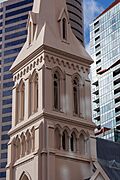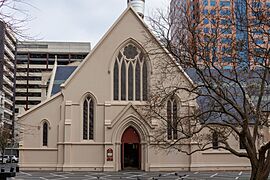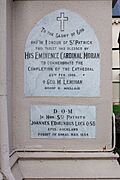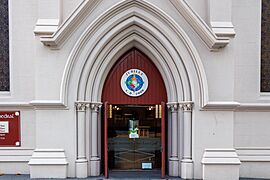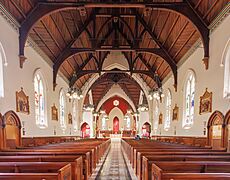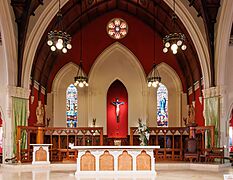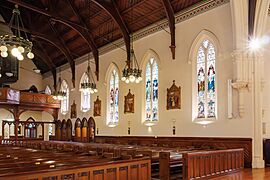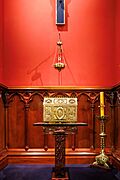St Patrick's Cathedral, Auckland facts for kids
Quick facts for kids St Patrick's Cathedral |
|
|---|---|
| Cathedral of Saint Patrick and Saint Joseph | |

The cathedral from St Patrick's Square
|
|
| 36°50′47″S 174°45′49″E / 36.8465°S 174.7635°E | |
| Location | Auckland Central City |
| Country | New Zealand |
| Denomination | Catholic |
| History | |
| Status | |
| Founded | 1843; 182 years ago |
| Founder(s) | Bishop Jean-Baptiste Pompallier, 1st Bishop of Auckland |
| Dedication | |
| Dedicated | 23 February 1908 |
| Consecrated | 1 September 1963 |
| Architecture | |
| Functional status | Active |
| Architect(s) |
|
| Architectural type | Church |
| Style | Gothic Revival |
| Administration | |
| Parish | St Patrick's Cathedral |
| Diocese | Auckland |
The Cathedral of Saint Patrick and Saint Joseph, often called St Patrick's Cathedral, is a very old and important Catholic church in Auckland CBD, New Zealand. It stands at the corner of Federal Street and Wyndham Street. This church is the main church for the Roman Catholic Diocese of Auckland. It is also where the Bishop of Auckland has his special seat.
In 1841, Bishop Jean-Baptiste Pompallier, who was the first Catholic bishop in New Zealand, bought the land for the church. A small wooden chapel was built in 1843. Later, a stone church replaced it in 1848. This stone church was made bigger in 1884. Finally, the church you see today was finished in 1907. St Patrick's became a cathedral in 1848. It was officially blessed in 1963.
Heritage New Zealand recognized the cathedral as a special historic place. It was listed as a Category I historic place on September 6, 1984.
Contents
How the Cathedral Began
The church is built on land given by the government to Bishop Jean-Baptiste Pompallier. This happened on June 1, 1841. In the 1840s, about 300 to 400 Catholic people lived in Auckland. Most of them were from Ireland. To help these people, a wooden chapel, a house for the priests, and a school room were opened. These buildings were blessed on January 29, 1843.
Soon after, work started on a stronger, more lasting church. In 1845, an architect named Walter Robinson came to Auckland. Bishop Pompallier had asked him to come. Robinson was hired to design a stone church. This new church was built on the same land, at the corner of Chapel Street (now Federal Street) and Wyndham Street.
At first, people called it a chapel, then a church. St Patrick's became the main Catholic cathedral in 1848. This happened when Auckland became its own diocese. Bishop Pompallier returned to Auckland in April 1850. He made Auckland, which was then New Zealand's capital, his main base. This first stone church was simple and plain. It could seat 700 people. It was made from local scoria stone and looked very strong.
On May 4, 1884, a new part of the church, called the nave, began to be built. The old stone church became the transept, which is the part that crosses the main body of the church. The altar was placed on the east wall, with a special space built for it in 1895. The architect for this big addition was Edward Mahoney. Between 1884 and 1885, the nave was made longer following Edward Mahoney's plans. The new nave had a tower, and its bells came all the way from Rome. The organ was bought from Brompton Oratory in London for £600. Archbishop Redwood, from Wellington, opened this new part of the church on March 15, 1885.
The Cathedral Today
Building the Current Cathedral
Around the year 1900, the cathedral was again too small. Auckland's population was growing fast. Thomas Mahoney, Edward Mahoney's son and business partner, drew up plans. These plans were for making the stone church even bigger. They included larger transepts. In 1907, the cathedral was finally completed. The nave was extended by another 12.2 meters. A special area called a sanctuary was added. Four sacristies (rooms for priests) and two side chapels were also built. Three large entrance porches were added, one of which became the baptistry.
On February 23, 1908, the newly rebuilt St Patrick's Cathedral opened. Cardinal Francis Moran, the Archbishop of Sydney, was there. The church was full, with 1,300 people attending the opening.
Consecration and Restoration
On September 1, 1963, St Patrick's Cathedral was officially blessed. It was free of debt and built with strong, lasting materials. Archbishop James Liston led the special ceremony.
A big project to restore the cathedral finished in 2007. This project changed the inside of the cathedral. The chancel area was turned into a special chapel for the Blessed Sacrament. Icon-style paintings of the Blessed Virgin Mary and the Holy Family were placed on the side altars. The old high altar was replaced by a large raised area. This area holds the altar, the bishop's special throne, a reading stand, and a baptismal font. Water flows constantly from the font towards the north. Another special item in the cathedral is a silk tapestry. It has been hanging on the west wall of the north transept since 1989.
Interesting Connections
- A grapevine growing outside the cathedral is thought to have come from a vine brought to New Zealand by Bishop Pompallier himself.
- In 1940, New Zealand's Prime Minister, Michael Joseph Savage, passed away. After a special Mass in Wellington, his body traveled by train. It rested in St Patrick's Cathedral before being buried at Bastion Point. The Savage Memorial was built there in his honor.
- St Patrick's Cathedral, especially its tall spire, was a key location in the 1988 film The Navigator: A Medieval Odyssey. This movie was directed by Vincent Ward.
- Two former Bishops of Auckland are buried in the Cathedral. They are George Michael Lenihan (who was bishop from 1896 to 1910) and John Mackey (who was bishop from 1974 to 1983).
Cathedral Leaders
The priests who have led the Cathedral as Administrators include:
- John Baptist Petit-Jean (1842–1845)
- John Forest (1845–1850)
- Henry Fynes (1850–1852)
- James McDonald (1852–1869)
- Michael O'Hara (1869–1871)
- Walter McDonald (1871–1886)
- Patrick Costello (1887)
- Victor Thomas (1888)
- James Hackett (1889–1895)
- W J Madden (1895–1897)
- Thomas Mulvihill (1897–1898)
- Patrick O'Reilly (1899–1901)
- James Patterson (1901–1905)
- Henry Holbrook (1905–1913)
- Matthew Brodie (1913–1915)
- Jeremiah Cahill (1915–1916)
- William Murphy (1916–1918)
- John Brennan (1918–1919)
- William Forde (1919–1921)
- John Brennan (1921–1923)
- John Bradley (1924–1925)
- Leonard Buxton (1925–1942)
- Adrian Curran (1942–1970)
- Brian Arahill (1971– 1988)
- (????)
- Michael Bancroft (1998–1999)
- Bernard Kiely (1999–2017)
- Peter Tipene (2017–2021)
- Christopher Denham (2021–2025)
- Craig Dunford (2025-present)
Music Directors
- Douglas Mews (1970–1982)
Images for kids
Outside the Cathedral
Inside the Cathedral
See also
 In Spanish: Catedral de San Patricio y San José (Auckland) para niños
In Spanish: Catedral de San Patricio y San José (Auckland) para niños



